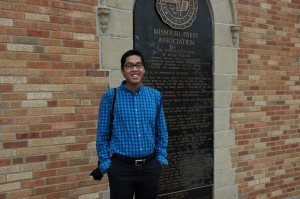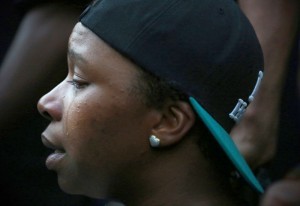
On Monday, Nov. 9, student journalist Tim Tai found himself in the middle of the story at the University of Missouri campus in Columbia when he tried to cover protests that led to top university officials resigning.
With much of the response to the story focusing on the reaction to how MU staff treated Tai and other journalists on the Mel Carnahan Quadrangle, the 20-year-old senior from St. Louis says there was no way he could have backed down from covering the story.
Below is a little bit about Tai in his own words, including what drives him as a journalist and what it was like covering some of the state’s biggest stories in recent years.
What brought you to Columbia?
I applied to 19 colleges for a variety of majors, including journalism. I got into roughly half of the schools I applied to and was trying to decide whether to pursue journalism or architecture, ultimately. I decided on journalism, thinking I didn’t have the artistic skills necessary to become an architect, and Mizzou was the most financially feasible option, by a long stretch.
In addition, former J-school undergraduate dean Brian Brooks recruited me through the Walter Williams Scholars program and I also was offered the opportunity to do research as a freshman with Professor Clyde Bentley through the Honors College’s Discovery Fellows program, which really appealed to me.
How did you first become interested in photography?
I asked my parents for a DSLR in my last semester of high school, thinking photography would be an easy thing to pick up for fun or as a side job. Needless to say, I was not very good when I started but had a strong desire to get better at it, because I figured that if I was going to spend time doing something, I was going to learn to do it well. I hate settling for mediocrity.
When I decided to go to Mizzou, I didn’t really know anything about photojournalism. It wasn’t on my radar and I had no idea of the rich history of the school’s photojournalism program – the world’s first, I believe. I was interested in doing something integrating technology or coding with journalism.
At the start of freshman year, my roommate, who had gotten into photography in high school, said something about considering photojournalism but deciding to go into strategic communication instead because there were more jobs and better financial security. I laughed and agreed at the time but something about that exchange stuck with me and I started looking into the photojournalism sequence and asking myself if I might be interested in pursuing it. And I was still taking photos for fun, and started going to community events to practice taking photos and investing in more equipment and whatnot, and that’s how I ended up becoming a photojournalist.
What do you look for when shooting a subject?
Great journalism, and photojournalism in particular, is about taking the reader or viewer or listener on a journey. Most stories, whether written or visual, are going to be forgotten by the next day if they only convey literal information about what happened. The stories that stick are the ones that make you feel something, as if you’re present at the actual scene rather than simply looking at it from afar.
So when I’m photographing, I’m always trying to think about how to make a picture that makes the viewer feel something when they look at it. You assess the mood or feeling of the situation you’re in, and try to figure out how to convey that feeling — through the moment, light, color, composition and distance to subject. You think about composing with a foreground, midground and background, to place the viewer in the middle of the scene. If all of these things work together to communicate the feeling of the situation, then you’ve succeeded.
Sometimes, it’s not possible to get everything to work together that way, since as journalists we can’t alter the scene but only document it, and the elements may not all be present at every assignment or story. But that’s the goal. (And I’m stealing a lot of this explanation from the phenomenal photo editor and current Syracuse professor Mike Davis, but it’s to me the clearest way of understanding how to make a successful photograph.)
Do you have a favorite image or collection of images you’ve captured over the years?
I don’t know that I have a favorite photo — I tend not to be personally attached to my work, though there are plenty of situations I’ve worked in that really stick out to me. But if I had to pick a photo that my mind keeps coming back to, it’s an image of Michael Brown’s mother, Lesley McSpadden, with a single tear rolling down her cheek, taken at a vigil the day after Brown was shot.

Later that night was the first wave of rioting and looting that sometimes accompanied the protests that would continue for several straight weeks and have sparked a national movement. The reason I keep coming back to this photograph is because everything else – protests, movements, grand jury deliberations – aside, a mother lost her son. That is an intensely personal grief even amid such a public reaction.
Because I’m from St. Louis and was in town when this vigil was held, before most of the national news organizations arrived, I was able to make this picture. It reminds me that behind every big “news story” is someone’s personal story.
Regarding your past work: how would you describe your experience covering Ferguson?
Ferguson was a very complicated situation. As I mentioned, I began covering it, so to speak, the day after Michael Brown was shot. I was in St. Louis between finishing an internship and waiting for school to begin again, had seen the news the night he was killed on Twitter and saw a very powerful image by the Post-Dispatch’s David Carson. I heard there was a vigil the next day (Sunday) and decided to go out there and use photography as a way of trying to interpret the situation myself, as I really wasn’t sure what had happened — rumors and accusations were flying, and community members were both outraged and mourning. I wasn’t on assignment at the time.
After that night’s looting and subsequent police response, which I avoided by going home just before it started, the story gained national attention and I decided to keep following it. But it was frustrating on many levels. For one, the police were always sort of an unpredictable factor. Were they going to arrest journalists that day? Or just fire tear gas again? The mood of the protests could turn on a dime as well. Some nights were more festive and upbeat while other nights seemed destined to end in tear gas.
Occasionally, journalists would be threatened by some people in the crowds — perhaps not protestors, but people interested in stirring up trouble. A few journalists were physically assaulted and/or had their equipment damaged. I was never physically hurt, because I made sure to always park somewhere with an escape route (the police had begun to close area roads each evening) and also knew that it was not worth getting hurt for a photograph, so I tended not to stick around when the tear gas was deployed. Many journalists had gas masks and were able to take powerful photographs amid the tear gas, but I didn’t have the resources to purchase one and decided that it was not worth the risk of injury or arrest.
After the first week, the presence of other news media was overwhelming, and the police had also got a lot of blowback and were being ordered to stop interfering with journalists (as well as lessen their response to the protestors). It became difficult to make unique pictures, since it began to feel that, though the protestors’ outrage and pain was real, the protests themselves were to a degree playing to the cameras. It’s hard to make good pictures of people holding up signs. You want to make viewers feel something as soon as they look at the photo, not make them have to read something.
Also, the coverage was all very reactive. Michael Brown’s family stayed out of the public eye. Virtually no one in the apartment complex where he was shot were willing to talk or be photographed. The Ferguson Police Department sure wasn’t going to allow photographers to do a ride-along with them. There was no way at the time to document any sort of the structural issues of racism that people in Ferguson (and other North St. Louis counties) were talking about.
That was very frustrating, because reactive coverage can only be so meaningful. My friend and former classmate Mark Kauzlarich has been working for almost a year now on a photo project documenting everyday life in Ferguson (http://markkauzlarich.com/when-you-enter-into-a-city/), but after the national media left, I think a lot of those issues just stopped receiving attention again.
Regarding the campus protests: How did you remain calm in the face of so many people pushing back?
Personally, I don’t think I really remained that calm. When I first saw the video was posted online, I didn’t have time to watch it because I was filing pictures but I was horrified. I thought I would never get another call from ESPN again. I thought I was pointlessly arguing and shouting too much. It wasn’t until later that night that I realized that people were praising me. Then I finally found time to watch the video and was horrified again.
As a photojournalist, my role is intrinsically intrusive, to a degree, and I’ve been in plenty of situations where the people you are trying to photograph don’t want you to be there. Sometimes, you put the camera down because you’re going to cause more harm than potential good, or the picture is just not worth it. But when you’re covering breaking national news on a public lawn, that’s not one of those times. And I also knew that there was no way I could go back to my editor at ESPN, Tim Rasmussen, and say, sorry, they didn’t want me to take pictures so I don’t have anything to send to you. I couldn’t go back to any photo editor and say that when it’s a story like the one on campus.
I think a lot of photojournalists who are starting out are afraid to approach people for fear of being told no, or afraid to ask people for their names, etc. At least, I went through that phase. But at a certain point, I think you kind of get over it. For me, it was realizing that if I want to be a photojournalist, I have to be proud of what I do, and that means there’s no time to waste being bashful. Not everyone is going to want their photo taken and sometimes you accept that and move on and sometimes you have an obligation to the public, and the historical record, to take the photo anyway.
I’ve seen plenty of other photojournalists act calmly in similar situations, and most even more calmly than I did, so I don’t think what I did was unique. It just happened to be caught on video. But I never could imagine doing anything less calm. Journalists can’t be getting into fistfights with their subjects.
Do you have any advice for other young journalists or photographers who might face hostility from their subjects?
How you respond is a situation-by-situation basis. What is the story? What is your goal as a journalist? What good or harm will come from pushing the issue? You kind of get a feel for these issues as you get more experience dealing with them. If you’re doing a feature story on a private individual in town and they don’t want to give you access, then you just kill the story and move on. But if it’s a much bigger story that attracts a lot of public attention, and the subjects have, in a sense, become public figures, then you have an obligation to the public to document it.
Sometimes, if tensions are running high, you can try to slow things down and have a calm discussion about your goal and why you are trying to take photos. Other times, the communication has totally broken down and that no longer works. I think that’s what happened on campus with me. There had been a lot of anti-media sentiment over the week leading up to that Monday, and the crowd had already adopted an us vs. them mentality toward reporters. I don’t think any sort of reasoning in the moment could have led to more access. So then you kind of just have to ignore it and do your job as best as you can.
Remember, also, that journalists need to take the legal high ground and not break the law while working. (An exception might be an investigative or watchdog piece, i.e., immersion journalism, though that’s a totally different discussion.) But never be tempted to do anything that would constitute assault or battery while working. Don’t trespass. Etc. Breaking the law opens you up to criminal charges as well as undermines the integrity of your work.
I would have had no issue had the students at the protest just stood there with their hands up to block my photos. My problem is with them physically shoving me and other journalists back, putting their hands on my (and other photographers’) gear, and even one person (apart from the professor in the video) threatening to beat up another photographer, which I overheard. Even when this is happening, though, journalists should always do what is legally defensible.
What are your plans for after college?
I’m not sure. I’ve been applying for newspaper internships and will probably apply for staff photojournalist jobs in the spring as well.


